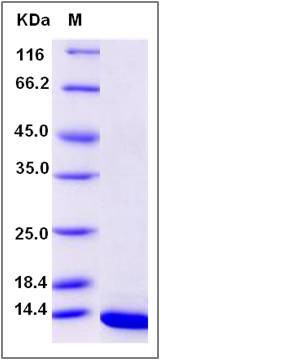Mouse / Human / Rat / Cynomolgus / Canine BDNF Protein
BDNF
- 100ug (NPP3189) Please inquiry
| Catalog Number | P50240-MNAS |
|---|---|
| Organism Species | Mouse |
| Host | CHO Stable Cells |
| Synonyms | BDNF |
| Molecular Weight | The recombinant mature form of mouse BDNF consists of 119 amino acids and predicts a molecular mass of 13.5 KDa. |
| predicted N | His 131 |
| SDS-PAGE |  |
| Purity | > 95 % as determined by SDS-PAGE |
| Protein Construction | A DNA sequence encoding the mouse BDNF (P21237) (Met1-Arg249) was expressed and its mature form was purified. The mature form of human, mouse, rat, cynomolgus and canine BDNF sequences are identical. |
| Bio-activity | 1. Measured by its ability to bind biotinylated human TrkB-His (P10047-H08H) in functional ELISA. 2. Measured by its ability to bind Human TrkB-Fch (P10047-H03H) in functional ELISA. 3. Measured by its ability to bind biotinylated mouse TrkB-His (P50132-M08H) in functional ELISA. |
| Research Area | Neuroscience |Neurology process |Growth and Development |Axon Guidance |Neurotrophic Factor & Receptor in Axon Guidance |
| Formulation | Lyophilized from sterile PBS 1. Normally 5 % - 8 % trehalose and mannitol are added as protectants before lyophilization. Specific concentrations are included in the hardcopy of COA. |
| Background | BDNF is a member of the nerve growth factor family. It is highly expressed in hippocampus, amygdala, cerebral cortex and cerebellum. It also can be detected in heart, lung, skeletal muscle, testis, prostate and placenta. BDNF is induced by cortical neurons, and is necessary for survival of striatal neurons in the brain. During development, BDNF promotes the survival and differentiation of selected neuronal populations of the peripheral and central nervous systems. It participates in axonal growth, pathfinding and in the modulation of dendritic growth and morphology. It functions as the major regulator of synaptic transmission and plasticity at adult synapses in many regions of the CNS. The versatility of BDNF is emphasized by its contribution to a range of adaptive neuronal responses including long-term potentiation (LTP), long-term depression (LTD), certain forms of short-term synaptic plasticity, as well as homeostatic regulation of intrinsic neuronal excitability. |
| Reference |
